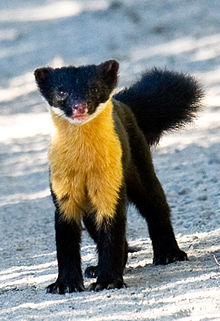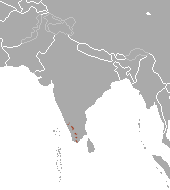Nilgiri marten
 From Wikipedia - Reading time: 11 min
From Wikipedia - Reading time: 11 min
| Nilgiri marten | |
|---|---|

| |
| Scientific classification | |
| Domain: | Eukaryota |
| Kingdom: | Animalia |
| Phylum: | Chordata |
| Class: | Mammalia |
| Order: | Carnivora |
| Family: | Mustelidae |
| Genus: | Martes |
| Species: | M. gwatkinsii
|
| Binomial name | |
| Martes gwatkinsii (Horsfield, 1851)
| |

| |
| Nilgiri marten range | |
| Synonyms | |
|
Charronia gwatkinsii | |
The Nilgiri marten (Martes gwatkinsii) is the only marten species native to southern India. It lives in the hills of the Nilgiris and parts of the Western Ghats. With only around a thousand members left it is listed as Vulnerable on the IUCN Red List.[1]
Characteristics
[edit]The Nilgiri marten is deep brown from head to rump, with the forequarters being almost reddish, with a bright throat ranging in colour from yellow to orange. It has a prominent frontal concavity and is larger than the yellow-throated marten.[2] It is about 55–65 cm (22–26 in) long from head to vent and has a tail of 40–45 cm (16–18 in). It weighs about 2.1 kg (4.6 lb).[3]: 6
Distribution and habitat
[edit]
The Nilgiri marten mainly inhabits the shola grassland and high altitude evergreen forests, and occasionally the adjacent mid-altitude moist deciduous forests and commercial plantations, that span the Western Ghats in the South Indian states of Karnataka, Kerala, and Tamil Nadu. The marten's English common name is derived from the Nilgiri Hills that form the center of its range, but sightings have been reported as far north as Charmadi Ghat and as far south as the Neyyar and Peppara Wildlife Sanctuaries.[4][5][6][7][8][9]
Behaviour and ecology
[edit]The Nilgiri marten is diurnal. It is mainly arboreal, but descends to the ground occasionally. It is omnivorous and preys on birds, small mammals (including the Malabar giant squirrel) and insects such as cicadas.[10][2] It has also been observed feeding on a variety of fruits and seeds.[11]
Taxonomy
[edit]The Nilgiri marten was described by Thomas Horsfield based on a skin in the museum of the East India Company; it is named after the collector Reynolds Gwatkins.[12]
References
[edit]- ^ a b Mudappa, D.; Jathana, D. & Raman, T. R. S. (2016) [errata version of 2015 assessment]. "Martes gwatkinsii". IUCN Red List of Threatened Species. 2015: e.T12847A86161239. doi:10.2305/IUCN.UK.2015-4.RLTS.T12847A45199025.en. Retrieved 9 March 2022.
- ^ a b Prater, S. H. (2005) [1971]. The Book of Indian Animals (3rd ed.). Mumbai: Bombay Natural History Society, Oxford University Press.
- ^ Hussain, S. A. (1999). "Mustelids, Viverrids and Herpestids of India: Species Profile and Conservation Status". ENVIS Bulletin: Wildlife and Protected Areas. 2 (2): 1–38.
- ^ Christopher, G. & Jayson, E. A. (1996). "Sightings of Nilgiri marten (Martes gwatkinsii Horsfield) at Peppara Wildlife Sanctuary and Silent Valley National Park, Kerala, India". Small Carnivore Conservation. 15: 3–4. Archived from the original on 19 April 2020.
- ^ Madhusudan, M. D. (1995). "Sighting of the Nilgiri marten (Martes gwatkinsii) at Eravikulam National Park, Kerala, India". Small Carnivore Conservation. 13: 6–7. Archived from the original on 19 April 2020.
- ^ Gokula, V. & Ramachandran, N. K. (1996). "A record of the Nilgiri marten (Martes gwatkinsii Horsfield) in Upper Bhavani". Journal of the Bombay Natural History Society. 93 (1): 82.
- ^ Mudappa, D. (1999). "Lesser Known Carnivores of the Western Ghats". ENVIS Bulletin: Wildlife and Protected Areas. 2 (2). Dehradun: Wildlife Institute of India: 65–70.
- ^ Balakrishnan, P. (2005). "Recent sightings and habitat characteristics of the endemic Nilgiri Marten Martes gwatkinsii in Western Ghats, India". Small Carnivore Conservation. 33: 14–16. Archived from the original on 19 April 2020.
- ^ Krishna, K. & Karnad, D. (2010). "New records of the Nilgiri marten Martes gwatkinsii in the Western Ghats, India". Small Carnivore Conservation. 43: 23–27. Archived from the original on 19 April 2020.
- ^ Hutton, A. F. (1948). "Feeding habits of the Nilgiri marten [Charronia gwatkinsii (Horsfield)]". Journal of the Bombay Natural History Society. 48 (2): 355–356. ISSN 0006-6982.
- ^ Anil, G.; Kishor, N.; Gafoor, N.; Ommer, N. & Nameer, P. O. (2018). "Observations on the Nilgiri Marten Martes gwatkinsii (Mammalia: Carnivora: Mustelidae) from Pampadum Shola National Park, the southern Western Ghats, India". Journal of Threatened Taxa. 10 (1): 11226–11230. doi:10.11609/jott.3446.10.1.11226-11230.
- ^ Catalogue of the Mammalia in the Museum of the Hon. East-India Company. London: Printed by J. & H. Cox. 1851. pp. 99–101. doi:10.5962/bhl.title.32671. OCLC 1109424. OL 243736W.
External links
[edit]- Photographs: Close encounters in the wild
- NilgiriMarten.com (archived 26 December 2009)
 KSF
KSF